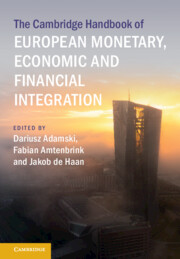Book contents
- The Cambridge Handbook of European Monetary, Economic and Financial Integration
- The Cambridge Handbook of European Monetary, Economic and Financial Integration
- Copyright page
- Contents
- Contributors
- Introduction
- Part I The Economic and Monetary Union
- 1 Conceptual Foundations of Economic and Monetary Union
- 2 Theorizing Economic and Monetary Union
- 3 Monetary Union and the Single Currency
- 4 On the Misalignment of Monetary, Economic, and Political Integration in European Economic and Monetary Union
- 5 Ideas, Interests, and Power
- 6 Coping with Economic Crises through Learning by Doing
- 7 The Political Economy of Reinsurance
- 8 Euro Crises, the Productivity Slowdown, and the EMU
- Part II The Monetary Dimension
- Part III The Economic and Fiscal Dimensions
- Part IV Financial Integration
- Index
- References
6 - Coping with Economic Crises through Learning by Doing
An Evolving Policy Response
from Part I - The Economic and Monetary Union
Published online by Cambridge University Press: 28 September 2023
- The Cambridge Handbook of European Monetary, Economic and Financial Integration
- The Cambridge Handbook of European Monetary, Economic and Financial Integration
- Copyright page
- Contents
- Contributors
- Introduction
- Part I The Economic and Monetary Union
- 1 Conceptual Foundations of Economic and Monetary Union
- 2 Theorizing Economic and Monetary Union
- 3 Monetary Union and the Single Currency
- 4 On the Misalignment of Monetary, Economic, and Political Integration in European Economic and Monetary Union
- 5 Ideas, Interests, and Power
- 6 Coping with Economic Crises through Learning by Doing
- 7 The Political Economy of Reinsurance
- 8 Euro Crises, the Productivity Slowdown, and the EMU
- Part II The Monetary Dimension
- Part III The Economic and Fiscal Dimensions
- Part IV Financial Integration
- Index
- References
Summary
The series of crises after 2007 exposed shortcomings in the design of Economic and Monetary Union (EMU) in Europe and the difficulty of arriving at solutions. This chapter traces the evolving policy responses to these crises and asks whether they go far enough to underpin the future sustainability and resilience of the eurozone. It examines the background to the problems EMU encountered, then contrasts the policy responses to the sovereign debt crisis of the early 2010s with those enacted to deal with the economic consequences of COVID-19. Although the extent of governance reform in the EU and, specifically, the eurozone is prone to be under-estimated, more needs to be done. The chapter identifies and analyses several remaining gaps in the governance framework, focusing on three areas: the future of EU fiscal rules, the need for and likely nature of a supranational fiscal capacity, and the consequences of economic divergence among eurozone members. It concludes that despite some consensus on what needs to be done, decisive action is needed to strengthen the governance of the eurozone, failing which, the future resilience of the euro cannot be taken for granted. The challenges are as much political as technical.
- Type
- Chapter
- Information
- Publisher: Cambridge University PressPrint publication year: 2023



